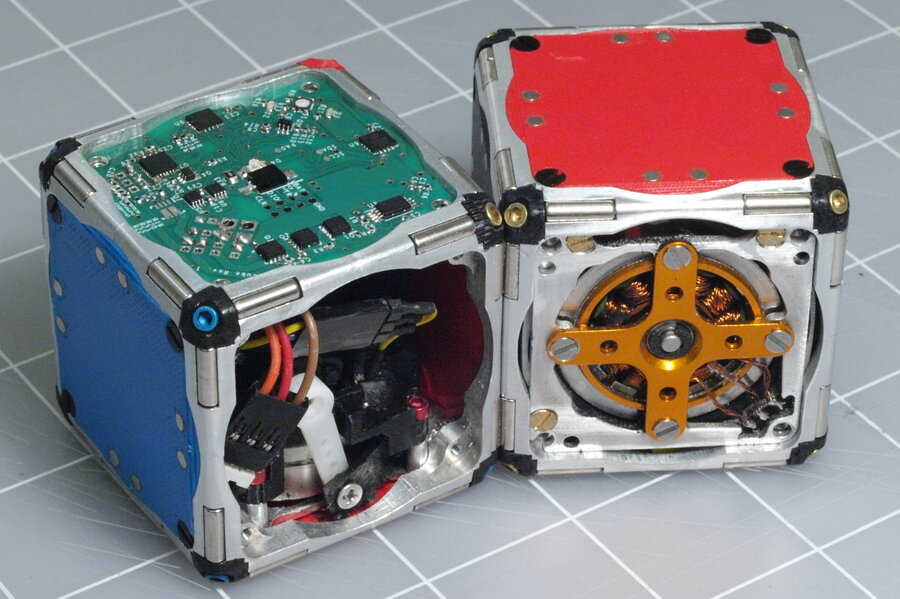MIT's self-assembling robots: the building blocks of the future
Loading...
It starts with a buzz, a quiver, and a sudden jump.
That's how the Massachusetts Institute of Technology's new M-blocks operate. The self-assembling cube robots could potentially transform to tackle various tasks – from inspecting tight spaces to morphing into everyday objects – all from a relatively simple design.
The blocks have no exterior moving parts but contain a small motor inside.
"That motor spins up a flywheel, and that flywheel has a large moment of inertia, and so by spinning, the cube stores a bunch of energy in the flywheel," says Kyle Gilpin, a postdoctoral associate who worked on the project.
The flywheel runs at up to 20,000 revolutions per minute, but a braking mechanism stops it in about a hundredth of a second. The M-blocks then use the angular momentum from their flywheels to move. When the wheel stops, it imparts its energy to the rest of the cube.
"All energy stored in that flywheel is then transferred to the body of the cube, causing it to roll or to jump or to climb as you saw in the video," Mr. Gilpin says.
The cubes align using small magnets on every face. Their edges are also magnetized to allow them to "climb" on top of each other, keeping them connected while a cube flips from one face to the next.
"The magnets allow them to climb on metal structures," explains Daniela Rus, director of the MIT Computer Science and Artificial Intelligence Laboratory.
Ms. Rus says the team is focused on the science of self-assembly and the new capabilities that can be achieved with modular robots.
"If you do not know ahead of time what your robot will have to do and when it will have to do it, if you have a robot capable of synthesizing whatever is needed for the locomotion, manipulation, or sensing of the task, then you have more capability, more flexibility," she says.
Gilpin says the modules can always be used to create particular objects, although it might not be as cheap as going out to buy the object itself. However, he says the blocks could be used in situations in which size and weight are valuable resources, for example on a space station.
Experts have argued that self-reconfiguring robots can be particularly helpful in space exploration, morphing into any shape necessary to complete different tasks.
In 2000, a team at the Palo Alto Research Center developed PolyBot, a chain robot that could slither like a snake, crawl like a spider, or inch along like a worm. NASA has expanded on the idea of PolyBot with a plan for its own "Snakebot," which would perform more functions than the stiff Mars Rover because of its versatility.
Snakebots can be used to conduct surgery, inspect small places, and even rescue a cat from a tree (researchers at Carnegie Mellon University have developed snakebots that, when thrown, quickly wrap around tree limbs and lampposts).
But Rus says snakebots are fixed configuration robots, while M-blocks can make structures of different geometries.
"For example, the structure can be a long ledge which might allow the robots to traverse a gap," she explains. "The snake is also linear, but has a fixed size. If the snake has to traverse a gap that is longer than its body, the task will be impossible."
In the future, Rus says the team would like to have M-blocks that can conduct more reasoning and planning than the current prototypes.






